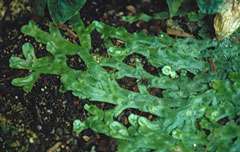Conocephalum conicum
Conocephalum conicum, the great scented liverwort,[1] common mushroom-headed liverwort[1] or snakeskin liverwort, is a liverwort species in the genus Conocephalum .
| Conocephalum conicum | |
|---|---|
 | |
| Conocephalum conicum – a thallose liverwort | |
| Scientific classification | |
| Kingdom: | |
| Division: | |
| Class: | |
| Order: | |
| Family: | |
| Genus: | |
| Species: | C. conicum |
| Binomial name | |
| Conocephalum conicum | |
A lunularic acid decarboxylase has been detected from C. conicum.[2]
The larvae of the moth Epimartyria pardella feed on C. conicum.
Description
Conocephalum conicum has very wide thalli which can form large mats.
Thalli
The thalli can grow to 17 meters wide, large for a liverwort. The thalli are very strong-smelling, with purplish margins; a dark green, leathery surface; flat and smooth. They smell slightly of stale urine and fecal matter. This is due to the copious amount of sulfur and nitrogen it absorbs from the soil. There is a set of lines running along the thalli's surface. The air pores, which are found between the lines, are more conspicuous.
Reproductive structures
Male plants bear unstalked, terminal cushions. Female plants have terminal conical receptacles on stalks, which are shortly lobed.[3]
References
- Edwards, Sean R. (2012). English Names for British Bryophytes. British Bryological Society Special Volume. 5 (4 ed.). Wootton, Northampton: British Bryological Society. ISBN 978-0-9561310-2-7. ISSN 0268-8034.
- Lunularic acid decarboxylase from the liverwort Conocephalum conicum. Robert J. Pryce, Linda LintonPhytochemistry, November 1974, Volume 13, Issue 11, Pages 2497–2501, doi:10.1016/S0031-9422(00)86926-5
- Atherton, Ian D.M.; Bosanquet, Sam D.S.; Llawley, Mark, eds. (2010). Mosses and Liverworts of Britain and Ireland: A Field Guide (PDF). British Bryological Society. p. 255. ISBN 978-0956131010. Retrieved 13 April 2015.